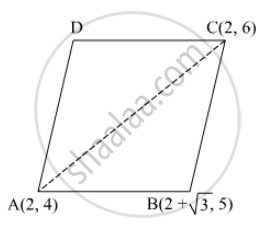Advertisements
Advertisements
प्रश्न
Find the area of a parallelogram ABCD if three of its vertices are A(2, 4), B(2 + \[\sqrt{3}\] , 5) and C(2, 6).
उत्तर
It is given that A(2, 4), B(2 + \[\sqrt{3}\] , 5) and C(2, 6) are the vertices of the parallelogram ABCD.

We know that the diagonal of a parallelogram divides it into two triangles having equal area.
∴ Area of the parallogram ABCD = 2 × Area of the ∆ABC
Now,
\[\text{ ar} \left( ∆ ABC \right) = \frac{1}{2}\left| x_1 \left( y_2 - y_3 \right) + x_2 \left( y_3 - y_1 \right) + x_3 \left( y_1 - y_2 \right) \right|\]
\[ = \frac{1}{2}\left| 2\left( 5 - 6 \right) + \left( 2 + \sqrt{3} \right)\left( 6 - 4 \right) + 2\left( 4 - 5 \right) \right|\]
\[ = \frac{1}{2}\left| - 2 + 4 + 2\sqrt{3} - 2 \right|\]
\[ = \frac{1}{2} \times 2\sqrt{3}\]
\[ = \sqrt{3}\text{ square units } \]
∴ Area of the parallogram ABCD = 2 × Area of the ∆ABC = 2 × \[\sqrt{3}\] = 2 \[\sqrt{3}\] square units
APPEARS IN
संबंधित प्रश्न
The base PQ of two equilateral triangles PQR and PQR' with side 2a lies along y-axis such that the mid-point of PQ is at the origin. Find the coordinates of the vertices R and R' of the triangles.
Name the quadrilateral formed, if any, by the following points, and given reasons for your answers:
A(-3, 5) B(3, 1), C (0, 3), D(-1, -4)
Show that the points A (1, 0), B (5, 3), C (2, 7) and D (−2, 4) are the vertices of a parallelogram.
If (2, p) is the midpoint of the line segment joining the points A(6, -5) and B(-2,11) find the value of p.
`"Find the ratio in which the poin "p (3/4 , 5/12) " divides the line segment joining the points "A (1/2,3/2) and B (2,-5).`
ABCD is rectangle formed by the points A(-1, -1), B(-1, 4), C(5, 4) and D(5, -1). If P,Q,R and S be the midpoints of AB, BC, CD and DA respectively, Show that PQRS is a rhombus.
Find the centroid of ΔABC whose vertices are A(2,2) , B (-4,-4) and C (5,-8).
If P ( 9a -2 , - b) divides the line segment joining A (3a + 1 , - 3 ) and B (8a, 5) in the ratio 3 : 1 , find the values of a and b .
In \[∆\] ABC , the coordinates of vertex A are (0, - 1) and D (1,0) and E(0,10) respectively the mid-points of the sides AB and AC . If F is the mid-points of the side BC , find the area of \[∆\] DEF.
Write the coordinates the reflections of points (3, 5) in X and Y -axes.
If A (2, 2), B (−4, −4) and C (5, −8) are the vertices of a triangle, than the length of the median through vertex C is
If the centroid of the triangle formed by (7, x) (y, −6) and (9, 10) is at (6, 3), then (x, y) =
f the coordinates of one end of a diameter of a circle are (2, 3) and the coordinates of its centre are (−2, 5), then the coordinates of the other end of the diameter are
In which quadrant does the point (-4, -3) lie?
If segment AB is parallel Y-axis and coordinates of A are (1, 3), then the coordinates of B are ______
If the perpendicular distance of a point P from the x-axis is 5 units and the foot of the perpendicular lies on the negative direction of x-axis, then the point P has ______.
The perpendicular distance of the point P(3, 4) from the y-axis is ______.
If the coordinate of point A on the number line is –1 and that of point B is 6, then find d(A, B).
Assertion (A): The ratio in which the line segment joining (2, -3) and (5, 6) internally divided by x-axis is 1:2.
Reason (R): as formula for the internal division is `((mx_2 + nx_1)/(m + n) , (my_2 + ny_1)/(m + n))`
